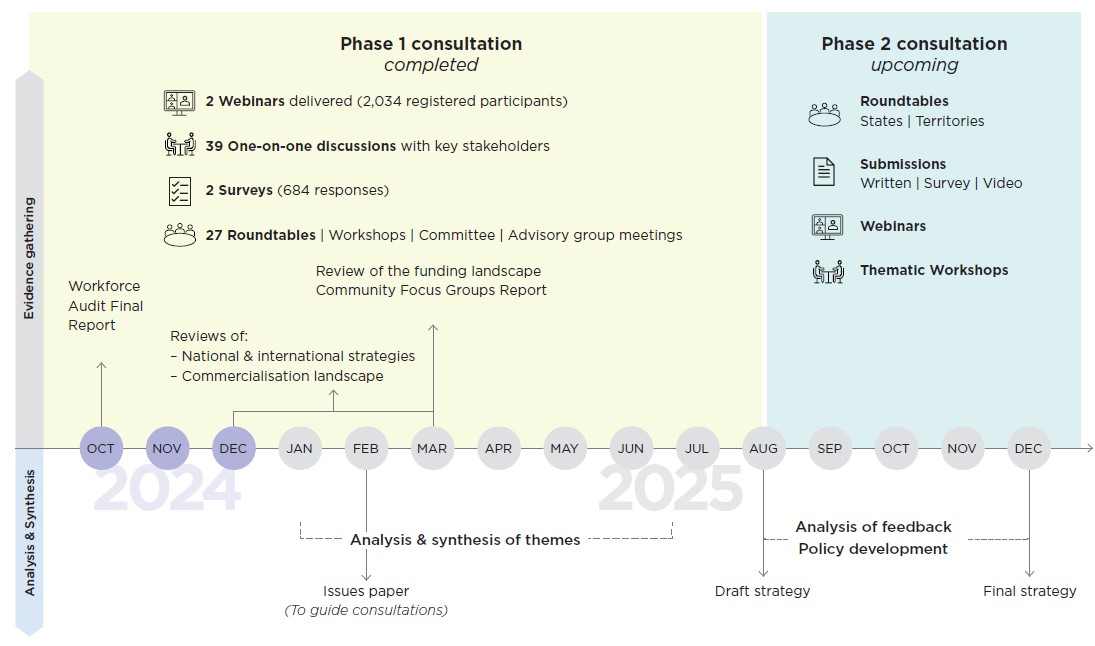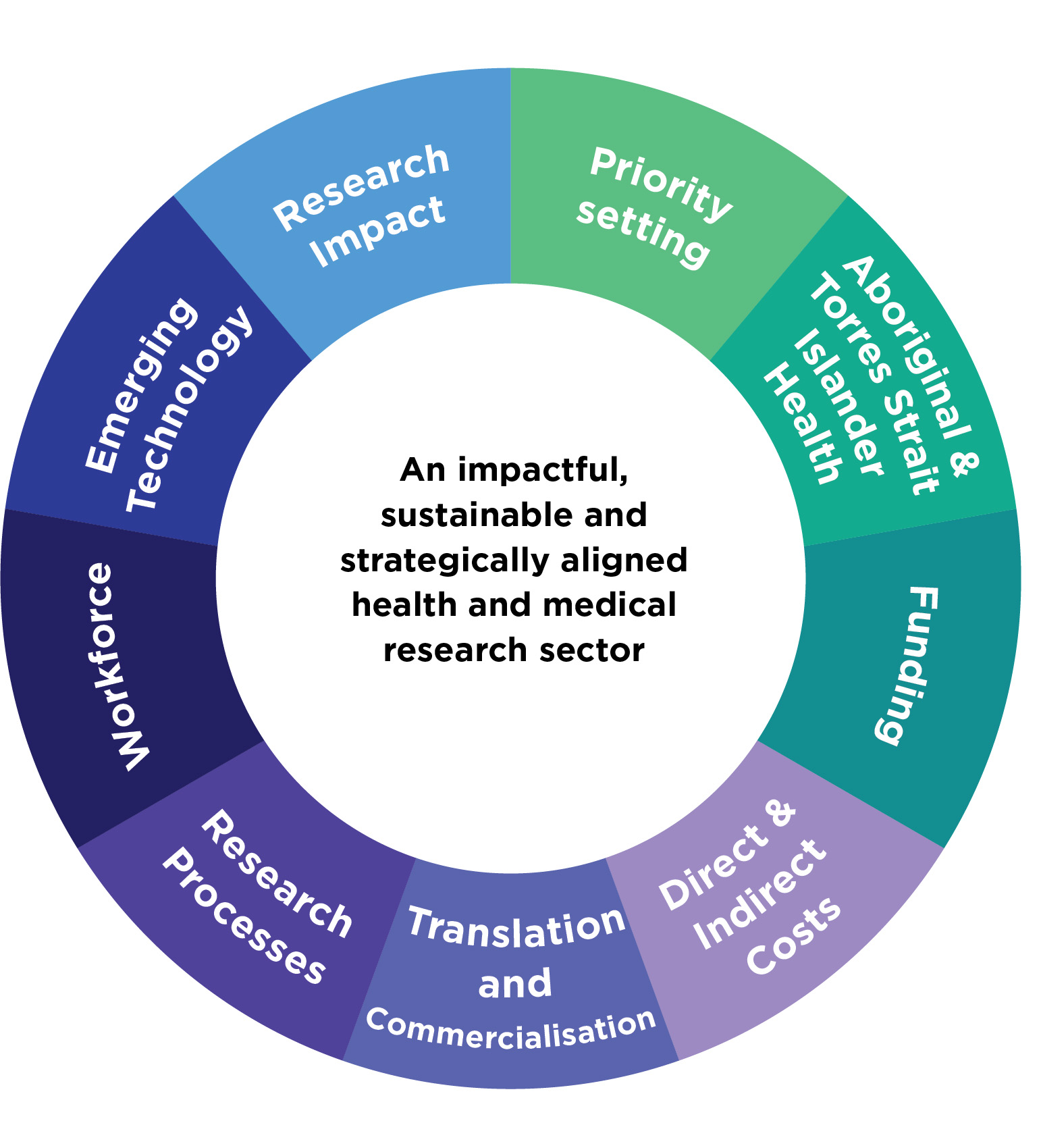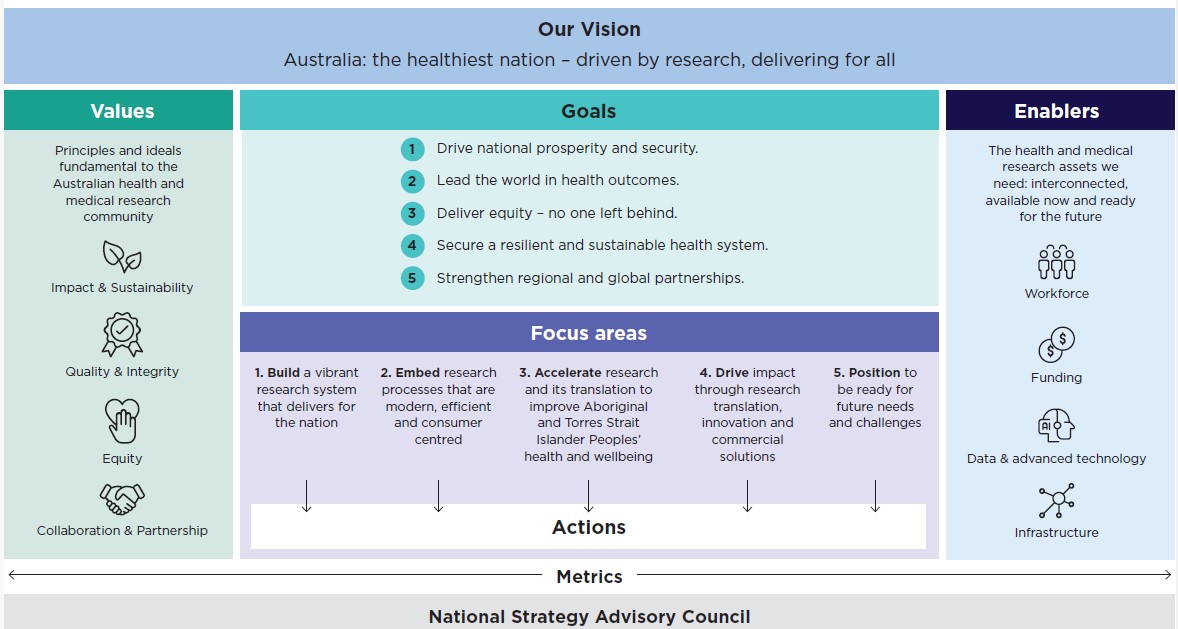On 27 August 2025, the Minister for Health, Disability and Ageing announced the release of the draft National Health and Medical Research Strategy (the National Strategy). The National Strategy will build on Australia’s strengths in health and medical research and leverage Australia’s world leading research capability. It will aim to attract researchers and investors, strengthen coordination and impact and improve health outcomes in communities. Feedback on the draft strategy was sought through a public consultation. The consultation closed on 8 October 2025 and submissions are being reviewed.
Publication Data
Table of contents
This is a draft of the National Health and Medical Research Strategy.
Chair’s Introduction
Ms Rosemary Huxtable AO PSM, Chair of the National Strategy
I am pleased to present, for consultation, the draft National Health and Medical Research Strategy.
The draft Strategy sets out a transformative 10 year vision to strengthen Australia’s health and medical research system. Supporting a thriving health and medical research ecosystem and skilled Australian researchers is essential for advancing knowledge and strengthening both the research and health sectors, ultimately leading to meaningful improvements in the wellbeing and prosperity of the Australian community.
The draft National Strategy is the result of a national consultation and evidence gathering process conducted throughout 2024–2025. It reflects the collective insights of researchers, clinicians, policymakers, industry leaders, Aboriginal and Torres Strait Islander researchers and community leaders and consumers.
The draft National Strategy will now enter phase 2 consultations, where stakeholders can provide formal feedback through submissions and by participating in webinars, workshops and roundtables. All feedback will be analysed and synthesised to identify common themes, gaps and opportunities, to inform the development of actionable solutions that address the sector’s needs and ambitions and place Australia at the forefront of global health and medical innovation.
I have been encouraged by the level of engagement and positive approach to developing solutions that has been a hallmark of the work to date and look forward to continuing those partnerships in this next phase of development.
Transforming health and medical research in Australia
Investing in a once in a generation transformation of health and medical research in Australia.
In May 2024, the Albanese Government announced the development of a National Health and Medical Research Strategy (National Strategy) to build on our national strengths and fill any gaps, while attracting researchers and investors.*
The need for a National Strategy has been one of the consistent messages the government has heard from the health and medical research sector.
The Department of Health, Disability and Ageing and the National Health and Medical Research Council (NHMRC) have led the development of the draft National Strategy for the Minister for Health, Disability and Ageing.
*Excerpt from Minister Butler's May press release.
National Health and Medical Research Strategy
Why do we need a National Health and Medical Research Strategy?
Health and medical research underpins a modern, outcomes focused health system that can deliver equitably for the community. It is the foundation upon which health treatments, technologies and models of care are discovered, trialled, translated and commercialised, helping to improve health outcomes and, as a result, enabling a strong economy and fair society. The development of a National Strategy provides a unique opportunity to examine the evidence, consult broadly, engage on reform ideas and build on the ideas of previous reviews and consultations, to ensure our health and medical research sector is fit for purpose for the future.
National Strategy purpose
The purpose of a National Strategy is to:
- Deliver a plan to strengthen and leverage Australia’s world leading research capability, leading to better health outcomes from a productive and efficient research ecosystem.
- Provide strategic direction across the entire research continuum from initial discovery through to translation and scalable manufacturing of transformative research outcomes.
- Ensure equity, access, and workforce development through inclusive policies, broad participation and sustained investment in a diverse, skilled research community.
- Align and integrate with other strategic initiatives including the Strategic Examination of Research and Development (SERD), National One Stop Shop (NOSS) and the National Science and Research Priorities.
Australia has been at the forefront of many new discoveries and research innovations that have transformed health outcomes and led to global impacts. The strengths of Australian health and medical research, its skilled workforce and contribution to productivity and economic growth have benefited, and continue to benefit, the health of communities.
An outcomes-focused health and medical research ecosystem
Examples of Australian health and medical research outcomes:
- Indigenous Birthing on Country services1
- Gardasil® and CervarixTM cancer vaccines2
- CSL – local access to rapid medical advances since 19163
- Vaccine for chikungunya virus for the Asia Pacific region4
- Cochlear implants5
- Australian Corneal Graft Registry6
- FeSS Protocols for stroke7
- NADINA melanoma trial8
- National Bowel Cancer Screening Program9
- Genomator synthetic data generator10
- GM-CSF discovery, development and use.11
National Strategy development process

Phase 1 consultation
Phase 1 consultation was completed between October 2024 and March 2025. An Issues Paper was released in December 2024 to guide consultation.
Consultations undertaken included:
- 2 Webinars delivered (2,034 registered participants)
- 39 One-on-one discussions with key stakeholders
- 2 Surveys (684 responses)
- 27 meetings of Roundtables, Workshops, Committees and Advisory Groups.
Outputs of consultation included:
- A Workforce Audit Final Report in October 2024
- An Issues paper in December 2024
- Reviews of national and international strategies; the commercialisation landscape; the funding landscape; and community focus groups in March 2025.
An analysis and synthesis of themes was undertaken from January to June 2025, and the draft National Strategy released in August 2025.
Phase 2 consultation
Phase 2 consultation commenced in August 2025 with the release of the draft National Strategy.
Opportunities for further consultation on the draft National Strategy include:
- Roundtables with States and Territories
- Public submissions, which can be written or recorded
- Webinars
- Thematic Workshops.
Following an analysis of feedback and policy refinement, a final National Strategy will be developed by December 2025.
Phase 1 consultations: what the National Strategy should aspire to
Themes that have emerged through the consultation process

Research impact
- Require greater accountability for research outcomes – at project and aggregate levels
- Undertake regular assessment of research impact
- Measure the impact of health and medical research on productivity and the economy.
Emerging technology
- Undertake horizon scanning to understand costs and opportunities of emerging technologies
- Realise the benefits of artificial intelligence to healthcare delivery
- Improve data sharing and data access to support efficient research processes.
Workforce
- Provide greater opportunity for early to mid-career researchers
- Consider career pathways and future sector needs in workforce planning
- Build diversity and equity across the research workforce particularly at senior levels.
Research processes
- Embed research processes that are efficient and drive strategic outcomes
- Promote community and consumer involvement as a systematic feature of research
- Embed research culture in healthcare organisations
- Streamline processes related to grant funding, ethics, governance, data sharing and regulatory processes.
Translation and commercialisation
- A focus on translation from the start of a research project
- Enhance researcher skills, health service and industry partnerships to promote translation and commercialisation
- Address regulatory barriers to commercialisation
- Increase visibility of the economic benefits of research taken to scale through translation and commercialisation pathways.
Direct and indirect costs
- Improve sustainability of research organisations through shared infrastructure, improved research processes and by addressing indirect costs.
Funding
- Greater visibility and monitoring of research funding in public, private and not for profit domains to support a coordinated funding approach
- Reduce areas of duplication and address unmet need.
Aboriginal & Torres Strait Islander Health
- Prioritise investment in Aboriginal and Torres Strait Islander health research that is co-designed and community led
- Develop innovative solutions in ‘Close the Gap’ priority areas through translation of proven research
- Continue to develop the Aboriginal and Torres Strait Islander workforce.
Priority setting
- Systematic, transparent and coordinated priority setting that is evidence-based, nuanced and responsive
- Greater geographic and sector balance across the research and development landscape
- A focus on regional, rural and remote research
- A balanced focus that includes burden of disease and the impact of rare diseases.
National Strategy vision, values and goals
Impactful research. Healthier Australians. Stronger nation

- Image description: Figure 4
Our Vision
Australia: the healthiest nation – driven by research, delivering for all
Values
Principles and ideals fundamental to the Australian health and medical research community:
- Impact & Sustainability
- Quality & Integrity
- Equity
- Collaboration & Partnership.
Goals
- Drive national prosperity and security.
- Lead the world in health outcomes.
- Deliver equity – no one left behind.
- Secure a resilient and sustainable health system.
- Strengthen regional and global partnerships.
Focus Areas
- Build a vibrant research system that delivers for the nation
- Embed research processes that are modern, efficient and consumer centred
- Accelerate research and its translation to improve Aboriginal and Torres Strait Islander Peoples’ health and wellbeing
- Drive impact through research translation, innovation and commercial solutions
- Position to be ready for future needs and challenges
Enablers
The health and medical research assets we need: interconnected, available now and ready for the future:
- Workers
- Funding
- Data and advanced technology
- Infrastructure.
National strategy ‘architecture’
The National Strategy uses a number of key concepts to construct a Strategy architecture that maps the path from vision to performance metrics.
All elements of the architecture work together to create a cohesive and purposeful design.
| Key concepts | Definition |
|---|---|
| Vision | The Vision is aspirational and future focused, setting the tone of the National Strategy and guiding all its elements. |
| Values | Values underpin the National Strategy and serve to orient and guide actions, behaviours and decisions throughout implementation. |
| Goals | The Goals seek to achieve its Vision, with progress against these Goals monitored and measured over time. |
| Focus Areas | Focus Areas are the thematic domains across which Actions will be taken to deliver on the Goals. |
| Actions | Actions are specific initiatives – the bridge from ambition to implementation. |
| Enablers | Enablers and an enabling environment are the building blocks of a successful health and medical research ecosystem. They are the fundamental assets needed to deliver the Actions of the National Strategy. |
| Metrics | Performance metrics measure the success of the National Strategy across different time horizons. |
| Governance | A governance structure will enable transparent oversight and ensure the success of the 10-year National Strategy. |
Values
The National Strategy seeks to embed principles and ideals that underpin the National Strategy and serve to orient and guide actions, behaviours and decisions throughout implementation.
| Values | Activities |
|---|---|
| Impact & Sustainability | A sustainable research system that improves the health of the community, powers a high performing health system and delivers productivity benefits. |
| Make it Quality & Integrity | A research system that generates a high level of public trust through its integrity, relevance, quality and the ethical conduct of research. |
| Equity | A research system that delivers equity by embracing diversity, being inclusive in priority setting, research processes and distribution of resources and promoting a distributed, diverse workforce. |
| Collaboration & Partnership | A research system where collaboration and partnership achieve maximum impact for the community, from discovery science to translation, through investigator and priority-driven research. |
Goals
The Goals of the National Strategy seek to achieve its Vision, with progress against these Goals monitored and measured over time. A successful National Strategy will support the health system to:
| Key concepts | Definition |
|---|---|
| Drive national prosperity and security | Boost Australia’s economy, sovereign capability and long term security through investment in medical research and innovation. |
| Lead the world in health outcomes | Make Australia the world’s healthiest country through research informed policy and practice. |
| Deliver equity – no one left behind | Ensure every Australian, regardless of background or postcode, benefits from health and medical research. |
| Secure a resilient and a sustainable health system | Support a cost effective, future ready system that meets population needs and economic conditions. |
| Strengthen regional and global partnerships | Position Australia as a trusted and leading partner in global health, especially in the Indo-Pacific region. |
Focus Areas
Focus Areas are the thematic domains for the Actions that will deliver on the Goals of the National Strategy.
| Focus areas | Definition |
|---|---|
| 1. Build a vibrant research system that delivers for the nation | Coordination of priorities and investment strategies across all health and medical research funders, with a focus on horizon scanning, partnerships and shared infrastructure will build a vibrant health and medical research system. This system will deliver impactful research that improves the health of Australians and contributes to national productivity and sustainability, now and in the future. |
| 2. Embed research processes that are modern, efficient and consumer centred | Well-coordinated, modern, efficient research processes that reduce administrative burden on researchers and drive consumer engagement and co-design will enable a more effective and sustainable health and medical research sector. |
| 3. Accelerate research and its translation to improve Aboriginal and Torres Strait Islander peoples’ health and wellbeing | More community driven research led by Aboriginal and Torres Strait Islander health and medical researchers and removal of structural inequities to research translation will improve Aboriginal and Torres Strait Islander health outcomes. |
| 4. Drive impact through research translation, innovation and commercial solutions | Mechanisms that incentivise and support research translation, commercialisation and industry growth will deliver economic gains, a robust biotech and medtech sector and health system capability, resilience and future preparedness. |
| 5. Position to be ready for future needs and challenges | Knowledge exchange and harnessing artificial intelligence (AI) will ensure Australia has capacity, trust in science and sovereign capability to monitor and address global risks and opportunities. This capability will support Australia to face future health and environmental challenges and to be a strong contributor to global and regional partnerships. |
Enablers
Enablers and an enabling environment are the building blocks of a successful health and medical research ecosystem. They are the fundamental assets needed to deliver across all the Action areas of the National Strategy.
| Key concepts | Definition |
|---|---|
| Workforce | Improving funding stability and job security through innovative funding models and workforce planning, increasing productivity and creating a research positive culture. |
| Funding | Ensuring sufficient funding that is strategically coordinated across government, industry, not for profit and philanthropic sectors. |
| Data and advanced technology | Building capability in emerging technologies, AI and data, that is accessible and linked. |
| Infrastructure | Using existing and planning new infrastructure, platforms and networks as shared resources in a sustainable research system. |
References
1 NHMRC Impact Case Studies. Safer birthing for First Nations families: Case Study. https://www.nhmrc.gov.au/about-us/resources/impact-case-studies/safer-birthing-first-nations-families-case-study (accessed 16 July 25)
2 NHMRC Impact Case Studies. GARDASIL® – the HPV vaccine: Case Study. https://www.nhmrc.gov.au/about-us/resources/impact-case-studies/gardasilr-hpv-vaccine (accessed 16 July 25)
3 CSL – Local access to rapid medical advances since 1916. https://www.cslbehring.com.au/our-company (accessed 17 July 2025)
4 NHMRC Impact Case Studies. A vaccine for chikungunya virus. https://www.nhmrc.gov.au/about-us/resources/impact-case-studies/vaccine-chikungunya-virus (accessed 16 July 2025)
5 NHMRC Impact Case Studies. The cochlear impact restores hearing: Case Study. https://www.nhmrc.gov.au/about-us/resources/impact-case-studies/cochlear-implant-restores-hearing (accessed 16 July 2025)
6 NHMRC Impact Case Studies. Improving vision with corneal transplants. https://www.nhmrc.gov.au/about-us/resources/impact-case-studies/improving-vision-corneal-transplants (accessed 16 July 2025)
7 NHMRC Impact Case Studies. Improving Stroke Outcomes. https://www.nhmrc.gov.au/about-us/resources/impact-case-studies/improving-stroke-outcomes (accessed 16 July 2025)
8 Blank CU, Lucas MW, Scolyer RA et al (2024) Breakthrough melanoma treatment approved to be listed on PBS, The New England Journal of Medicine, vol 391, no. 18. https://melanoma.org.au/news/breakthrough-melanoma-treatment-approved-to-be-listed-on-pbs/ (accessed 16 July 2025)
9 NHMRC Impact Case Studies. Screening to prevent bowel cancer. https://www.nhmrc.gov.au/about-us/resources/impact-case-studies/screening-prevent-bowel-cancer (accessed 16 July 2025)
10 CSIRO. Australia e-Health Research Centre. Genomator: creating synthetic data based on logic-solving. https://aehrc.csiro.au/research/cloud-native-genomics/genomator-creating-synthetic-data-based-on-logic-solving/ (accessed 16 July 2025).
11 Ward C (2011). Granulocyte-macrophage colony stimulating factor discovery. CSIROpedia. CSIRO. https://csiropedia.csiro.au/granulocyte-macrophage-colony-stimulating-factor-discovery/ (accessed 16 July 2025).